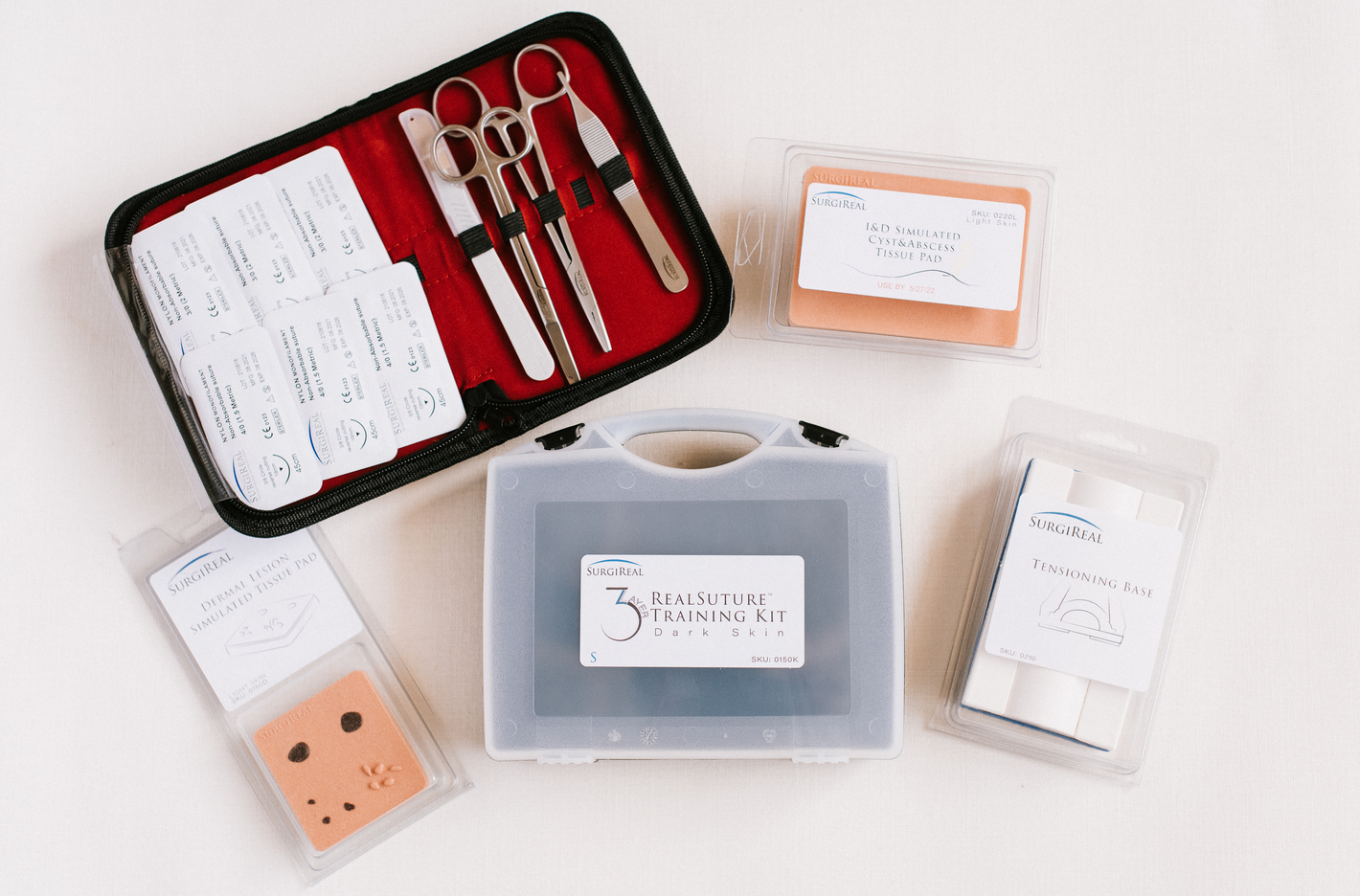
To learn more about our 6-Layer Clinical Bundle click here.
There are myriads of choices available on the market when it comes to purchasing a suture kit. For medical students and professionals alike, it can be a daunting task to sift through all the options and weigh the pros and cons of each kit. Thus, in this article, a list of the most important features to keep in mind is detailed below to facilitate your next purchase and aid you in your ongoing surgical success.
QUALITY = REALISM, REUSABILITY
Among the most important features of a suture kit is that of quality. The craftsmanship of the material will affect the longevity, reusability and ease of use of the tools. Working with subpar instruments not only makes practicing suturing cumbersome and ineffective, it can contribute to the formation of poor habits. This is especially crucial for learners who are just beginning to develop new skills. Medical students who use realistic simulated surgical material can significantly improve their suturing techniques. However the opposite rings true as well, the use of low quality material can greatly impede trainees confidence and competence, both of which are the cornerstones of excellent surgical practice. Furthermore, the more realistic and high quality the material is, the easier it is for students to feel that they are actually performing a surgical exercise, rather than performing some mindless manual task that is unrepresentative of real life. In other words, the closer the kit is to what one would find in an operation room, the better the retention of memory and said skills. This has been shown in various studies among surgical students who tested different simulative materials and determined silicone pads to be the best (Boyajian et al., 2019).
WHAT TO LOOK FOR IN A SUTURE PAD
Many “seemingly” more affordable suture pads found on the market are thin pieces of silicone that only provide superficial suturing, and then quickly degrade or tear after one or two uses. Not only do they need to be replaced frequently, they often fail to properly represent live tissue, making them questionable investments.
An easy test to determine the quality of the silicone is to see if it leaves a grease spot on the table after use; if it does, the silicone is of poor quality. High quality medical grade silicone will not leave stains or streaks on the table and can be used for hundreds of stitches without deteriorating.
SurgiReal offers 3-layer pads that allow for a minimum of 750 superficial sutures, while 6-layer pads allow for realistic practice of deep layer suturing, subcuticular suturing and multi-layer suturing for a minimum of 1500 sutures. These pads are reusable up to 10 times, making them much more worth it than the cheaply-made pads that only last 1-2 times. If you want to save money in the long-run, you are much better off buying quality, especially when it comes to suture kits.
Moreover, it is ideal for there to not be any pre-made incisions on the pads. The act of placing proper incisions is also a skill that requires learning and practice. It is very easy to pass the scalpel one hairline too far and cause more bleeding in patients. Pads without incisions are also more versatile in that they can be reused and incised in different directions and angles.
TYPE AND QUALITY OF OTHER TOOLS IN THE KIT
Almost all kits will contain other instruments of varying quality, size and type, as well as suture threads differing in type, quality and quantity. Ideally, all the tools required for surgical practice will be included in the kit, such as: tissue forceps, scalpel, stitch scissors, needle holder and packaged suture threads. Some tools in cheaply made suture kits are much smaller than those of real life or are so poorly made that they break after just a couple of uses. Other times the scissors barely cut or the needle holder and forceps do not clamp shut. These are all small details to consider prior to purchasing what may seem to be a great deal. A quality suture kit will last years if not decades, and provide the ideal learning and practice experience that is crucial for the technical betterment of surgical, emergency, nursing, veterinary pupils.
CARRYING CASE
Lastly, the carrying case of the suture kit should also be considered when shopping for your educational needs. Since suturing techniques need to be regularly practiced and revisited, it is best to find a kit that comes with a durable case so that one can easily organize, clean-up and carry the kit. Whether it is to practice at home or on-the-go during a lunch break, a well-made case will be most practical and effective at keeping your tools ready for use. Most cheap suture kits come in cardboard boxes that cannot withstand much pressure or wear and tear. As always, quality-made simulative surgical tools will win in the long run in terms of realism, reusability and cost effectiveness, all the while fostering surgical excellence.
To learn more about our 6-Layer Clinical Bundle click here.
REFERENCE
Boyajian, Michael & Lubner, Rory & Roussel, Lauren & Crozier, Joseph & Ryder, Beth & Woo, Albert. (2019). A Novel Suture Training Device to Innovate the Surgical Curriculum in Medical School. Plastic and Reconstructive Surgery - Global Open. 7. 121-122. 10.1097/01.GOX.0000584920.24826.29
